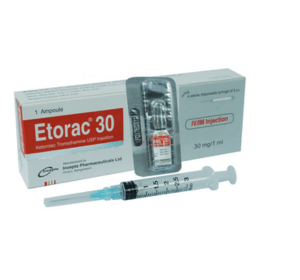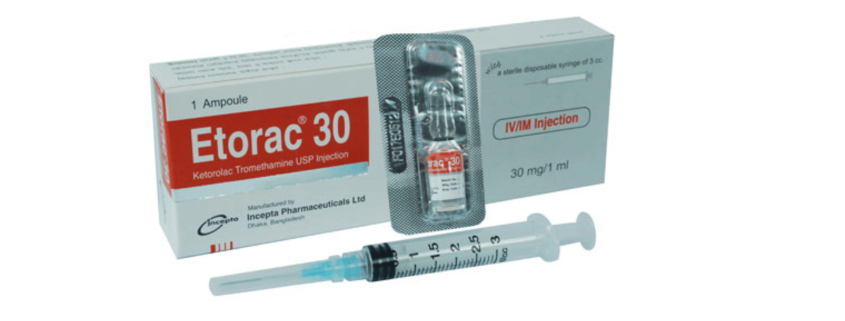Etorac(Ketorolac)

Therapeutic Group: Analgesic, Anti Inflammatory
Presentation
Etorac 30 IM/IV injection: Each 1 ml ampoule contains concentrated sterile solution of ketorolac Tromethamine USP 30 mg.
Etorac 60 IM injection: Each 2 ml ampoule contains concentrated sterile solution of Ketorolac Tromethamine USP 60 mg.
Etorac tablet : Each film coated tablet contains Ketorolac Tromethamine USP 10 mg.
Description
Ketorolac Tromethamine is a drug of pyrrolo-pyrrole group of nonsteroidal anti-inflammatory drug (NSAID). Chemically it is known as 5 benzoyle-2,3-dihydro-1H-pyrroligine-1-carboxylic acid, compound with 2 – amino-2-(hydroxymethyl)-1,3-propanediol (1:1). Ketorolac Tromethamine inhibits synthesis of prostaglandins and may be considered as a peripherally acting analgesic. The biological activity of Ketorolac Tromethamine is associated with the S-form. Pharmacokinetic property of Ketorolac Tromethamine is linear. It is highly protein bound and is largely metabolized in liver. The products of metabolism and some unchanged drugs are excreted in the urine.
Indications
Ketorolac Tromethamine is indicated for the short-term (<5 days) management of moderately severe acute pain that requires analgesia at the opioid level, (usually in postoperative setting). Therapy should always be started with Ketorolac Tromethamine IM/IV injection and Ketorolac Tromethamine oral is to be used only as continuation treatment, if necessary. Combined use of Ketorolac Tromethamine IM/IV and oral is not to exceed 5 days of use because of the potential of increasing the frequency and severity of adverse reactions associated with the recommended doses.
Dosage & Administration
Etorac injection
Etorac injection may be used as a single or multiple doses, on a regular or when necessary schedule for the management of moderately severe, acute pain that requires analgesia at the opioid level, usually in a postoperative setting. When administering Etorac injection, the IV bolus must be given over no less than 15 seconds. The IM administration should be given slowly and deeply into the muscle. The analgesic effect begins in ~30 minutes with maximum effect in 1 to 2 hours after dosing IV or IM. Duration of analgesic effect is usually 4 to 6 hours.
Single-Dose Treatment: The following regimen should be limited to single administration use only.
Adult Patients:
IM Dosing: Patients < 65 years of age: One dose of 60 mg. Patients > 65 years of age, renally impaired and/or less than 50 kg of body weight: One dose of 30 mg.
IV Dosing: Patients < 65 years of age: One dose of 30 mg. Patients > 65 years of age, renally impaired and/or less than 50 kg of body weight: One dose of 15 mg.
Pediatric Patients (2 to 16 years of age):
IM Dosing: One dose of 1 mg/kg up to a maximum of 30 mg.
IV Dosing: One dose of 0.5 mg/kg up to a maximum of 15 mg.
Multiple-Dose Treatment (IV or IM):
Patients <65 years of age: The recommended dose is 30 mg Etorac injection every 6 hours. The maximum daily dose should not exceed 120 mg. Patients >65 years of age, renally impaired patients , and patients less than 50 kg : The recommended dose is 15 mg Etorac injection every 6 hours. The maximum daily dose for these populations should not exceed 60 mg. For breakthrough pain, do not increase the dose or the frequency of Ketorolac Tromethamine.
Conversion from Parenteral to Oral Therapy:
Etorac tablets may be used either as monotherapy or as follow-on therapy to parenteral Ketorolac. When Etorac tablets are used as a follow-on therapy to parenteral Ketorolac, the total combined daily dose of ketorolac (oral + parenteral) should not exceed 120 mg in younger adult patients or 60 mg in elderly patients on the day the change of formulation is made. On subsequent days, oral dosing should not exceed the recommended daily maximum of 40 mg. Etorac IM should be replaced by Etorac tablet as soon as feasible. The total duration of combined parenteral and oral treatment should not exceed 5 days.
Etorac tablet
Adults: The usual oral dose of Etorac (Ketorolac Tromethamine) is 10 mg every 4 to 6 hours for pain as required. Doses exceeding 40 mg per day are not recommended. The maximum duration of treatment with the oral formulation is 5 days for post-surgical patients and 7 days for patients with musculoskeletal pain.
Patients Under 50 kg, over 65 years of age : The lowest effective dose is recommended.
Side Effects
It is generally well tolerated. However, side effects like dry mouth, excessive thirst, psychotic reactions, convulsion, myalgia, hyponatremia, hyperkalemia, raised blood urea and creatinine, renal failure, hypertension, bradycardia, chest pain, purpura, post operative haemorrhage, haematoma, liver function change etc may occur in some cases.
Gastrointestinal side-effects include abdominal discomfort, constipation, diarrhea, dyspepsia, flatulence, fullness, gastritis, gastrointestinal bleeding, gastrointestinal pain, nausea, pancreatitis, peptic ulcer, perforation, stomatitis, vomiting etc.
Precautions
Precaution should be taken in Elderly, Allergic disorder, Renal, cardiac & hepatic impairment, Porphyria, Patient with low body weight (<50kg).
Use in Pregnancy & Lactation
Pregnancy category C. Ketorolac Tromethamine is contraindicated in pregnancy and lactation.
Over Dose
Overdosage of Ketorolac Tromethamine may cause abdominal pain, peptic ulcers which healed after discontinuation of doses. Metabolic acidosis has been reported following intentional overdosage.
Commercial Pack
Etorac 30 IM/IV injection: Each box contains 1 ampoule of 1 ml sterile solution for injection of Ketorolac Tromethamine 30 mg.
Etorac 60 IM injection: Each box contains 1 ampoule of 2 ml sterile solution for injection of Ketorolac Tromethamine 60 mg.
Etorac tablet : Each box contains 3 blister strips of 10 tablets.



